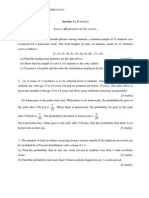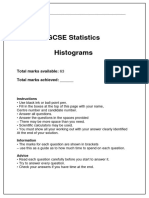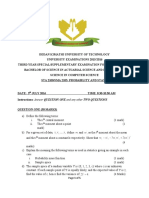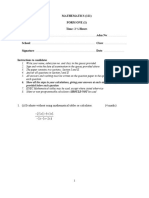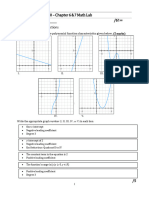Assignment
Assignment
Uploaded by
heidiCopyright:
Available Formats
Assignment
Assignment
Uploaded by
heidiCopyright
Available Formats
Share this document
Did you find this document useful?
Is this content inappropriate?
Copyright:
Available Formats
Assignment
Assignment
Uploaded by
heidiCopyright:
Available Formats
Maths Year 1 Assignment 11
Due Date: Friday 3rd March 2023
NAME…………………………………… CLASS……………
Instructions to Students
All questions must be attempted – get help from one of the Maths team if
you encounter any problems.
You should present your solutions on 5mm squared paper and submit
them with a copy of this question paper.
All work is to be handed in to your teacher on or before the due date
above – work handed in late may NOT be marked.
Teacher’s Mark: Grade:
This assignment is checking that you can……
• Draw stem and leaf diagrams
• Calculate Quartiles from a stem and leaf diagram
• Identify outliers using a given formula
• Draw box plots including outliers if necessary
• Draw histograms including dealing with rounded data
• Comment on the skewness of distributions
Comments or Actions for Improvement:
Abbeygate Sixth Form College 1
Maths Year 1 Assignment 11
1. The 19 employees of a company take an aptitude test. The scores out of 40 are illustrated in the stem and leaf
diagram below.
2|6 means a score of 26
0 7 (1)
1 88 (2)
2 4468 (4)
3 2333459 (7)
4 00000 (5)
Find
(a) the median score,
(1)
(b) the interquartile range.
(3)
The company director decides that any employees whose scores are so low that they are outliers will undergo
retraining.
An outlier is an observation whose value is less than the lower quartile minus 1.0 times the interquartile range.
(c) Explain why there is only one employee who will undergo retraining.
(2)
(d) Draw a box plot to illustrate the employees’ scores.
(3)
(Total 9 marks)
2. The number of caravans on Seaview caravan site on each night in August last year is summarised in the
following stem and leaf diagram.
Caravans 1|0 means 10 Totals
1 0 5 (2)
2 1 2 4 8 (4)
3 0 3 3 3 4 7 8 8 (8)
4 1 1 3 5 8 8 8 9 9 (9)
5 2 3 6 6 7 (5)
6 2 3 4 (3)
(a) Find the three quartiles of these data.
(3)
During the same month, the least number of caravans on Northcliffe caravan site was 31. The maximum number
of caravans that month was 72. The three quartiles for this site were 38, 45 and 52 respectively.
(b) On graph paper and using the same scale, draw box plots to represent the data for both caravan sites. You
may assume that there are no outliers.
(6)
(c) Compare and contrast these two box plots.
(3)
(d) Give an interpretation to the upper quartiles of these two distributions.
(2)
(Total 14 marks)
Abbeygate Sixth Form College 2
3. The variable x was measured to the nearest whole number. Forty observations are given in the table below.
x 10 – 15 16 – 18 19 –
Frequency 15 9 16
A histogram was drawn and the bar representing the 10 – 15 class has a width of 2 cm and a height of 5 cm. For
the 16 – 18 class find
(a) the width,
(1)
(b) the height
(2)
of the bar representing this class.
(Total 3 marks)
4. The histogram below shows the time taken, to the nearest minute, for 140 runners to complete a fun run.
Frequency
density
60.5 62.5 64.5 66.5 68.5 70.5 72.5 74.5 76.5 78.5 80.5 82.5 84.5 86.5 88.5 90.5 time
Use the histogram to calculate the number of runners who took between 78.5 and 90.5 minutes to complete the
fun run.
(Total 5 marks)
5. A teacher recorded, to the nearest hour, the time spent watching television during a particular week by each
child in a random sample. The times were summarised in a grouped frequency table and represented by a
histogram.
One of the classes in the grouped frequency distribution was 20–29 and its associated frequency was 9. On the
histogram the height of the rectangle representing that class was 3.6 cm and the width was 2 cm.
(a) Give a reason to support the use of a histogram to represent these data.
(1)
(b) Write down the underlying feature associated with each of the bars in a histogram.
(1)
(c) Show that on this histogram each child was represented by 0.8 cm2.
(3)
The total area under the histogram was 24 cm2.
(d) Find the total number of children in the group.
(2)
(Total 7 marks)
Abbeygate Sixth Form College 3
6. A college organised a ‘fun run’. The times, to the nearest minute, of a random sample of 100 students who took
part are summarised in the table below.
Time Number of students
40–44 10
45–47 15
48 23
49–51 21
52–55 16
56–60 15
(a) Give a reason to support the use of a histogram to represent these data.
(1)
(b) Write down the upper class boundary and the lower class boundary of the class 40–44.
(1)
(c) Draw a histogram to represent these data.
(4)
(Total 6 marks)
7. The total amount of time a secretary spent on the telephone in a working day was recorded to the nearest minute.
The data collected over 40 days are summarised in the table below.
Time (mins) 90–139 140–149 150–159 160–169 170–179 180–229
No. of days 8 10 10 4 4 4
Draw a histogram to illustrate these data.
(Total 4 marks)
8. (a) Describe the main features and uses of a box plot.
(3)
Children from school A and B took part in a fun run for charity. The times to the nearest minute, taken by the
children from school A are summarised in the figure below.
School A
10 20 30 40 50 60
Time (minutes)
(b) (i) Write down the time by which 75% of the children in school A had completed the run.
(ii) State the name given to this value.
(2)
(c) Explain what you understand by the two crosses ( ) on the figure above.
(2)
For school B the least time taken by any of the children was 25 minutes and the longest time was 55 minutes.
The three quartiles were 30, 37 and 50 respectively.
(d) Draw a box plot to represent the data from school B.
(4)
(e) Compare and contrast these two box plots.
(4)
(Total 15 marks)
Abbeygate Sixth Form College 4
9. The box plot shown below shows a summary of the weights of the luggage, in kg, for each musician in an
orchestra on an overseas tour.
20 30 40 50 60 70 80 90
Weight (kg)
The airline’s recommended weight limit for each musician’s luggage was 45 kg.
Given that none of the musicians’ luggage weighed exactly 45 kg,
(a) state the proportion of the musicians whose luggage was below the recommended weight limit.
(1)
A quarter of the musicians had to pay a charge for taking heavy luggage.
(b) State the smallest weight for which the charge was made.
(1)
(c) Explain what you understand by the + on the box plot in the diagram above, and suggest an instrument
that the owner of this luggage might play.
(2)
(d) Describe the skewness of this distribution. Give a reason for your answer.
(2)
(Total 6 marks)
10. The number of bags of potato crisps sold per day in a bar was recorded over a two-week period. The results are
shown below.
20, 15, 10, 30, 33, 40, 5, 11, 13, 20, 25, 42, 31, 17
(a) Calculate the mean of these data.
(2)
(b) Draw a stem and leaf diagram to represent these data.
(3)
(c) Find the median and the quartiles of these data.
(3)
An outlier is an observation that falls either 1.5 × (interquartile range) above the upper quartile
or 1.5 × (interquartile range) below the lower quartile.
(d) Determine whether or not any items of data are outliers.
(3)
(e) Draw a box plot to represent these data. Show your scale clearly.
(3)
(f) Comment on the skewness of the distribution of bags of crisps sold per day. Justify your answer.
(2)
(Total 16 marks)
11. (a) Explain what you understand by a census.
(1)
Each cooker produced at GT Engineering is stamped with a unique serial number. GT Engineering produces
cookers in batches of 2000. Before selling them, they test a random sample of 5 to see what electric current
overload they will take before breaking down.
(b) Give one reason, other than to save time and cost, why a sample is taken rather than a census.
(1)
(c) Suggest a suitable sampling frame from which to obtain this sample.
(1)
(d) Identify the sampling units.
(1)
(Total 4 marks)
Abbeygate Sixth Form College 5
You might also like
- Percentile PB Cummins EngineDocument7 pagesPercentile PB Cummins Enginegilar herliana putra100% (1)
- Year 9 Baseline Test - CalculatorDocument5 pagesYear 9 Baseline Test - CalculatornellytusiimeNo ratings yet
- Statistics Worksheet Math Studies IBDocument9 pagesStatistics Worksheet Math Studies IBJayesh Naresh AilaniNo ratings yet
- Enma 104 1.4Document23 pagesEnma 104 1.4Arjen Laron50% (2)
- Data Analytics in The Hospitality Industry HMPE 201Document23 pagesData Analytics in The Hospitality Industry HMPE 201Venice EspinozaNo ratings yet
- 2.18 Statistics IDocument18 pages2.18 Statistics INehemiah kipchumbaNo ratings yet
- Revision Math - StatisticsDocument16 pagesRevision Math - StatisticsOusy 14No ratings yet
- 5B09 - Section 2 Quiz - EDocument2 pages5B09 - Section 2 Quiz - EKelvin LauNo ratings yet
- Za M 1659888207 Grade 6 Maths Exam Paper November - Ver - 3Document23 pagesZa M 1659888207 Grade 6 Maths Exam Paper November - Ver - 3HeshaniNo ratings yet
- Mathematics Topical TestDocument2 pagesMathematics Topical TesthalmiamzahNo ratings yet
- S1 Maths Q ADocument12 pagesS1 Maths Q Ananastase41No ratings yet
- Statistics II QuizesDocument19 pagesStatistics II Quizesjumamaro100No ratings yet
- April 2024-Maths Assignment - 1Document11 pagesApril 2024-Maths Assignment - 1JANSHI CYBERNo ratings yet
- Ejercicios IB Media Moda MedianaDocument11 pagesEjercicios IB Media Moda MedianadiegocueNo ratings yet
- As Stats Chapter 3 Representations of Data Worksheet QP 3Document7 pagesAs Stats Chapter 3 Representations of Data Worksheet QP 3BONGLAV JemasonNo ratings yet
- Maths - MT 2Document4 pagesMaths - MT 2Tanya GoyalNo ratings yet
- MATH F1 QS Term 2 Opener 2023 Teacher Co KeDocument11 pagesMATH F1 QS Term 2 Opener 2023 Teacher Co Keerolahmad97No ratings yet
- Statistics II QDocument5 pagesStatistics II QHANS0% (1)
- F1 MATHS Qs END TERM 1 2024Document11 pagesF1 MATHS Qs END TERM 1 2024geoffreybyron71No ratings yet
- Math F1 QSDocument11 pagesMath F1 QSgeorgembunikeyaNo ratings yet
- Kapsabet Boys Math f1 Qs 2023Document11 pagesKapsabet Boys Math f1 Qs 2023dmwgichehaNo ratings yet
- Grade VI Maths ExamDocument24 pagesGrade VI Maths ExamIsraNo ratings yet
- Third Space Learning Venn Diagrams GCSE WorksheetDocument22 pagesThird Space Learning Venn Diagrams GCSE Worksheetkucing sanguNo ratings yet
- Mathematics Date:12/June/2024 Period: 8:30a.m-11:30a.mDocument10 pagesMathematics Date:12/June/2024 Period: 8:30a.m-11:30a.mWilly DerrickNo ratings yet
- 3-Representation of DataDocument12 pages3-Representation of DataMuhammad AsaadNo ratings yet
- f1 Maths C-hr 10 QpDocument44 pagesf1 Maths C-hr 10 QpjjNo ratings yet
- Scattergraphs Practice QuestionsDocument6 pagesScattergraphs Practice QuestionsᕱოᕱᏃᎥՈg TᕱᏉNo ratings yet
- P2 SMK Ampuan Durah SerembanDocument5 pagesP2 SMK Ampuan Durah SerembanmasyatiNo ratings yet
- Third Space Learning Geometric Sequences GCSE WorksheetDocument12 pagesThird Space Learning Geometric Sequences GCSE WorksheetFreddilyn BalmesNo ratings yet
- Median Lower Quartile Upper Quartile Lower Value Highest Value Boys GirlsDocument2 pagesMedian Lower Quartile Upper Quartile Lower Value Highest Value Boys GirlsIha WoodyNo ratings yet
- Paper 1 - Question PaperDocument16 pagesPaper 1 - Question Paperdanielowinoomollo244No ratings yet
- SEHH1070 Tutorial Exercise 3 PDFDocument3 pagesSEHH1070 Tutorial Exercise 3 PDFLinus KwokNo ratings yet
- F4-MATHS BookletDocument185 pagesF4-MATHS Bookletnabiswaj8No ratings yet
- 2023 Math 3 A En-1Document5 pages2023 Math 3 A En-1Marisa VetterNo ratings yet
- S12010 JanDocument13 pagesS12010 JanJianny MaganaNo ratings yet
- Colfes - 11+ - SampleDocument11 pagesColfes - 11+ - SamplekabirNo ratings yet
- Ird 101 (SB) 2013Document4 pagesIrd 101 (SB) 2013michelle anyokoritNo ratings yet
- Representation and Summary of DataDocument12 pagesRepresentation and Summary of DatamegaordinarydayNo ratings yet
- SBHS 2011 Yr 9 Yearly PDFDocument17 pagesSBHS 2011 Yr 9 Yearly PDFKevin QuachNo ratings yet
- Tutorial 04 Measure of PositionDocument3 pagesTutorial 04 Measure of Positionxuannn7777No ratings yet
- HCF and LCM - Worksheet: Skill Group A - Highest Common FactorDocument9 pagesHCF and LCM - Worksheet: Skill Group A - Highest Common FactorPaulette CaruanaNo ratings yet
- Mathematics 53035Document8 pagesMathematics 53035Daksh PNo ratings yet
- Third Space Learning Upper and Lower Bounds GCSE Worksheet 1Document11 pagesThird Space Learning Upper and Lower Bounds GCSE Worksheet 1erin zietsman0% (1)
- 17 S1 Specimen Paper and Mark SchemeDocument12 pages17 S1 Specimen Paper and Mark SchemeWierd Gal0% (1)
- 2024 GR 9 Data Handling and Transformation Geometry TutorialDocument17 pages2024 GR 9 Data Handling and Transformation Geometry TutorialSindi SibandaNo ratings yet
- DT 3 - Representation of DataDocument3 pagesDT 3 - Representation of DataSOPHIE AMELIE WIBOWONo ratings yet
- Advanced Mathematics 1Document5 pagesAdvanced Mathematics 1Tido KombaNo ratings yet
- MATH F1 QS Term 2 Opener 2023 Teacher - Co - KeDocument11 pagesMATH F1 QS Term 2 Opener 2023 Teacher - Co - Keadams sigilaiNo ratings yet
- Statistics S1 Revision Papers With AnswersDocument22 pagesStatistics S1 Revision Papers With AnswersKothakonda Praveen Kumar50% (2)
- Past ca 1Document5 pagesPast ca 1katsambas10No ratings yet
- Histograms Exam QuestionsDocument15 pagesHistograms Exam QuestionsChan KellyNo ratings yet
- SMA 2103 PROBABILITY AND STATISTICS I PrintreadyDocument5 pagesSMA 2103 PROBABILITY AND STATISTICS I PrintreadySaizzoh mozzarellaNo ratings yet
- Sma 2103 Probability and Statistics IDocument5 pagesSma 2103 Probability and Statistics ISaizzoh mozzarellaNo ratings yet
- Project JosephstarkDocument16 pagesProject JosephstarkserukwayajNo ratings yet
- Mathematics 1Document10 pagesMathematics 1amisikelvine4No ratings yet
- S2 Revision Material PDFDocument15 pagesS2 Revision Material PDFrachitNo ratings yet
- Simple StatDocument10 pagesSimple Statbader alsaloumNo ratings yet
- Math f1 Week 3 (Homepackage)Document8 pagesMath f1 Week 3 (Homepackage)otto silverstNo ratings yet
- Ama 4104 Maths For Scie AssignmentDocument3 pagesAma 4104 Maths For Scie Assignmentangelamaina001No ratings yet
- Edexcel GCE: Tuesday 17 January 2012 Time: 1 Hour 30 MinutesDocument15 pagesEdexcel GCE: Tuesday 17 January 2012 Time: 1 Hour 30 MinutesAbdulrahman HatemNo ratings yet
- s6 Subsidiary Mathematics Paper 1 Mock Exam 2020 St. Mary039s KitendeDocument4 pagess6 Subsidiary Mathematics Paper 1 Mock Exam 2020 St. Mary039s KitendeTumusiime osagyefo Johnbosco Adyeeri75% (4)
- f30_lab67-skply F2024Document8 pagesf30_lab67-skply F2024willyjunior60No ratings yet
- Define StatisticsDocument89 pagesDefine StatisticskhanjiNo ratings yet
- Mathematics: Quarter 4 - Module 2Document36 pagesMathematics: Quarter 4 - Module 2Ralph Alexis Dominise Pacursa50% (2)
- Midterms Sample Questions For March 2016Document3 pagesMidterms Sample Questions For March 2016Harold Q. GardonNo ratings yet
- Math10 Q4 M9Document15 pagesMath10 Q4 M9ivymarish.bucoNo ratings yet
- Chapter 10Document30 pagesChapter 10api-268597715100% (1)
- Resume Building Tips by PraffulDocument7 pagesResume Building Tips by Praffulshiva satyaNo ratings yet
- Assignment 2 CS Sec#4Document5 pagesAssignment 2 CS Sec#4shaheerahmed371No ratings yet
- Unit - 4 DMDocument24 pagesUnit - 4 DMmintoNo ratings yet
- Measures of Position: Ungrouped DataDocument26 pagesMeasures of Position: Ungrouped DataAlice KrodeNo ratings yet
- BBA Quiz 1Document7 pagesBBA Quiz 1Johnny ProNo ratings yet
- Math 10 q4 Week 1Document7 pagesMath 10 q4 Week 1Millet CastilloNo ratings yet
- Introduction To AnalyticsDocument50 pagesIntroduction To AnalyticsPrateesh DeepankarNo ratings yet
- Sas Teacher's GuideDocument51 pagesSas Teacher's GuideB.S.Krishna ShettyNo ratings yet
- Measures of Position For Ungrouped DataDocument18 pagesMeasures of Position For Ungrouped Datajohnmark.calmaNo ratings yet
- Chapter 3 - Measures DispersionDocument20 pagesChapter 3 - Measures Dispersion1974 Kazi SatiNo ratings yet
- Measures of PositionDocument19 pagesMeasures of PositionJeric EscandorNo ratings yet
- Tong Hop Cong Thuc SBDocument10 pagesTong Hop Cong Thuc SBKhải Hưng NguyễnNo ratings yet
- Sasa 1Document1 pageSasa 1nayeon jungNo ratings yet
- Measure of Variation: Range: ST RDDocument10 pagesMeasure of Variation: Range: ST RDRyan wilfred LazadasNo ratings yet
- Statistics Module 9-10: Speaking MathematicallyDocument8 pagesStatistics Module 9-10: Speaking MathematicallyFretxie mae Boholst100% (1)
- Year 11 Preliminary Standard Math: Analysing DataDocument32 pagesYear 11 Preliminary Standard Math: Analysing DataAlexander LaraNo ratings yet
- Instructional ModelDocument19 pagesInstructional ModelChell AmparoNo ratings yet
- Lecture No. 6 Measures of VariabilityDocument25 pagesLecture No. 6 Measures of VariabilityCzarina GuevarraNo ratings yet
- Bio Statistics 3Document13 pagesBio Statistics 3Moos LightNo ratings yet
- Learning Activity SheetDocument3 pagesLearning Activity SheetShuyen AmistadNo ratings yet
- ETW1001 Week 3: Pre-Class: A. Tables and Charts For Numerical DataDocument12 pagesETW1001 Week 3: Pre-Class: A. Tables and Charts For Numerical DataLiyendra FernandoNo ratings yet
- Computer Numerical and Statistical Method Unit 1 Calicut Univercitty NoteDocument24 pagesComputer Numerical and Statistical Method Unit 1 Calicut Univercitty Notetechexplorers2020No ratings yet




























